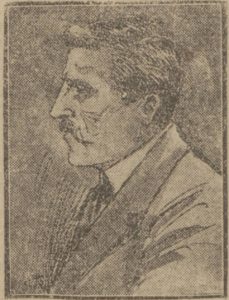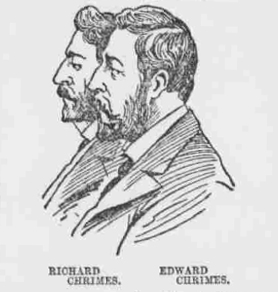
Baron Spolasco next moved on to Swansea, and celebrated the first anniversary of his rescue by paying for a whole ox to be distributed among the poor. He was, however, about to suffer a temporary reversal of his fortunes, for in 1839 he was arrested in connection with the death of a young woman.
Twenty-three-year-old Susannah Thomas consulted the Baron about abdominal pain. Her aunt’s statement at the inquest gives an insight into how he worked. The Baron allegedly
…told [Miss Thomas] he knew by her eyes, that she was very ill, and that he would cure her; afterwards she would have cause to bless the hour she saw the good Baron Spolasco. Witness was not allowed to relate the symptoms of the disorder of deceased to the Baron, as he said he could know them by her bold eye.
In return for 22s. 6d., he supplied two pills and some powder – the aunt noticed that this was exactly the same for all the other patients. Back home, Miss Thomas became worse, so her aunt sent for the Baron, who advised to try some castor oil and a gruel and turpentine clyster. A quarter of an hour after he left, Miss Thomas died. The autopsy revealed that her intestines were inflamed and her stomach ulcerated and gangrenous, with a hole in the stomach wall allowing the contents to escape into her abdominal cavity. The surgeon conducting the post mortem examination believed that the Baron’s medicines – composed of aloes and jalap – had hastened the patient’s death.
Baron Spolasco was charged with manslaughter and, furious about the ‘foul conspiracy got up against him’ was sent to gaol to await the next circuit court. When his trial came up, the surgeon could not say with certainty that the medicines were the cause of death and the Baron was found not guilty.
But it wasn’t long before he had another brush with the law. In March 1840 he was arrested for forging the government stamps on his pills. An undercover policeman went to the Baron’s house and was furnished with medicines whose stamps imitated a design discontinued in 1823. Spolasco’s defence was that the packets were intended for sale in Ireland, where stamps were not necessary. He again spent a few months in gaol waiting for the Assizes, and again was acquitted.
One might have expected him to lie low for a while after this troublesome time, but he was as ostentatious as ever and within a few months of getting out of gaol, he published a song (in both English and Welsh) lauding his genius.
I pledge unto Spolasco’s name,
A name in which we glory;
His splendid cures and healing fame
Recorded are in story.
Be mindful of Spolasco’s skill,
Ye patrons of his merit;
Save him from all impending ill.
And a relentless spirit.
It goes on in the same vein for ten verses.

(Thank you to Lucy Martin for the above photograph.)
The Baron remained in Swansea for several more years, and was mentioned in an inquest for the Rev. Edward Matthews Davies, who died of kidney disease in 1843. The Baron had tried to get him to hand over 20 guineas for consultation. Mr Davies’ servant asked whether such a large amount of money would actually result in a cure, and Baron Spolasco allegedly replied:
Do you think I would take any man’s money if I could not cure him? It is not the money I want, it is a name; I can get money as fast as I can count it.
It proved clear that the Rev Mr Davies had died of natural causes, and this time the Baron was not charged with anything. The coroner observed that:
…however culpable it might be to extort money from the pockets of a person labouring under a deadly disease, by pretending to cure him, yet a coroner’s jury could not deal with the case, unless it were proved that death was caused by the medicine prescribed.
At some point over the next few years, Baron Spolasco moved to London, remaining there until a 16-year-old servant girl stole a diamond ring from him, saying in her defence that she had taken it in revenge after he criminally assaulted her. She quickly changed her story to state that he had ‘taken a little liberty’ but that she had pushed him away. The Baron denied her allegations but appears not to have pressed charges for the theft. Soon afterwards he departed these shores for New York.
He carried on there just the same as he had done everywhere else, trumpeting his miracles and charging hefty fees for his advice. But he gradually went to seed and became the subject of Walt Whitman’s merciless description in ‘Street Yarn’ (1856):
Somebody in an open barouche, driving daintily. He looks like a doll; is it alive? We’ll cross the street and so get close to him. Did you see? Fantastic hat, turned clear over in the rim above the ears; blue coat and shiny brass buttons; patent leathers; shirt-frill; gold specs; bright red cheeks, and singularly definite jetty black eyebrows, moustache, and imperial. You could see that from the sidewalk; but you saw, when you stood at his wheel, not only the twinkling diamond ring and breast-pin, but the heavy, slabby red paint; and even the substratum of grizzly gray under that jetty dye; and upon our word there’s a hair of the same straggling out under the jaunty oiled wig! How straight he sits, and how he simpers, and how he fingers the reins with a delicate white little finger stuck out, as if a mere touch were all — as if his whole hand might govern a team of elephants! The Baron Spolasco, with no end of medical diplomas from all sorts of universities across the ocean, who cures everything immediately; you may consult him confidentially, or by letter, if you choose. It would be worth money to see that old gentleman — they say he is nearly eighty — undress himself! Clothes, wig, calves, stays, moustache, teeth, complexion — what a bald, bare, wizened, shriveled old granny he would be!
Though ‘they’ might have said Spolasco was pushing eighty, he was more like a mere 56. His fortunes declined and he moved to increasingly less salubrious parts of the city, defaulting on his rent each time. He died in 1858, unable to find a miraculous cure for his own cancer – but perhaps still mourning the death of his little son on the Cork coast twenty years before.



Captivating story, beautifully told.
Thanks, Michael!
Sad, tragic and told so well.
E
Thank you!
How will I ever be able to afford the good doctor now since I don’t have insurance?
He gave free advice to the poor between 9am and 10am, so if you get up early you’ll be OK. 🙂
“…but perhaps still mourning the death of his little son on the Cork coast twenty years before.”
Probably not. The guy couldn’t even dedicate his narrative to the poor boy.
Thanks for the story.
Thanks Jack. Although there is no record of Spolasco’s feelings towards the end of his life, I don’t think the lack of a dedication to his son implies much.
The dedication to Lady Roberts is in line with the usual practice of flattering people of high status even if the author had no personal connection with them.
In this case, Spolasco had a genuine reason to be grateful to Lady Roberts as she was involved in the rescue, and I think she’s an appropriate choice that reflects the conventions of the time.
i have one of these tokens, what is it worth
Hi Tom – probably about £40.
thank you, caro
Hi,
Do you know where I could find the full 10 verses of the Spolasco song?
Thanks
Tom
Hi Tom, it’s in the John Johnson Collection of Printed Ephemera, shelfmark Patent Medicines 21 (47).